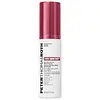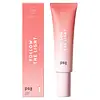What's inside
What's inside
 Key Ingredients
Key Ingredients

 Benefits
Benefits

 Concerns
Concerns

 Ingredients Side-by-side
Ingredients Side-by-side

Water
Skin ConditioningGlycolic Acid
BufferingPropanediol
SolventSodium Hydroxide
BufferingSimmondsia Chinensis Seed Oil
EmollientEthylhexyl Olivate
Skin ConditioningPolyglyceryl-2 Distearate
EmulsifyingC9-12 Alkane
SolventArachidyl Alcohol
EmollientZea Mays Starch
AbsorbentGlyceryl Stearate
EmollientNiacinamide
SmoothingTocopherol
AntioxidantAdansonia Digitata Seed Oil
EmollientCucurbita Pepo Seed Oil
EmollientRetinol
Skin ConditioningCollagen
MoisturisingAdenosine
Skin ConditioningSqualane
EmollientAllantoin
Skin ConditioningAscorbic Acid
AntioxidantPanthenol
Skin ConditioningLecithin
EmollientCeramide NP
Skin ConditioningVolcanic Soil
Skin ConditioningPullulan
Sodium Phytate
Arachidyl Glucoside
EmulsifyingAmylopectin
Polysorbate 20
Emulsifying1,2-Hexanediol
Skin ConditioningSilica
AbrasiveSodium Hyaluronate
HumectantLeuconostoc/Radish Root Ferment Filtrate
AntimicrobialPotassium Sorbate
PreservativeSclerotium Gum
Emulsion StabilisingCoco-Caprylate/Caprate
EmollientSodium Benzoate
MaskingXanthan Gum
EmulsifyingLysolecithin
EmulsifyingPentylene Glycol
Skin ConditioningPotassium Phosphate
BufferingEthylhexylglycerin
Skin ConditioningBehenyl Alcohol
EmollientAlcohol
AntimicrobialPhenoxyethanol
PreservativeMica
Cosmetic ColorantWater, Glycolic Acid, Propanediol, Sodium Hydroxide, Simmondsia Chinensis Seed Oil, Ethylhexyl Olivate, Polyglyceryl-2 Distearate, C9-12 Alkane, Arachidyl Alcohol, Zea Mays Starch, Glyceryl Stearate, Niacinamide, Tocopherol, Adansonia Digitata Seed Oil, Cucurbita Pepo Seed Oil, Retinol, Collagen, Adenosine, Squalane, Allantoin, Ascorbic Acid, Panthenol, Lecithin, Ceramide NP, Volcanic Soil, Pullulan, Sodium Phytate, Arachidyl Glucoside, Amylopectin, Polysorbate 20, 1,2-Hexanediol, Silica, Sodium Hyaluronate, Leuconostoc/Radish Root Ferment Filtrate, Potassium Sorbate, Sclerotium Gum, Coco-Caprylate/Caprate, Sodium Benzoate, Xanthan Gum, Lysolecithin, Pentylene Glycol, Potassium Phosphate, Ethylhexylglycerin, Behenyl Alcohol, Alcohol, Phenoxyethanol, Mica
Water
Skin ConditioningGlycolic Acid
BufferingGlycerin
HumectantIsononyl Isononanoate
EmollientPropanediol
SolventCetearyl Isononanoate
EmollientLactobacillus/Punica Granatum Fruit Ferment Extract
Skin ConditioningGlucamine
HumectantLactobacillus
Skin ConditioningLactic Acid
BufferingPolyglyceryl-4 Caprate
EmulsifyingSodium Hydroxide
BufferingXanthan Gum
EmulsifyingSclerotium Gum
Emulsion Stabilising3-O-Ethyl Ascorbic Acid
Skin ConditioningAllantoin
Skin ConditioningBisabolol
MaskingMica
Cosmetic ColorantSodium Stearoyl Glutamate
CleansingCocos Nucifera Fruit Extract
EmollientSodium PCA
HumectantCentella Asiatica Leaf Extract
Skin ConditioningGlycyrrhiza Glabra Root Extract
BleachingSalicylic Acid
MaskingAloe Barbadensis Leaf Juice Powder
Skin ConditioningCamellia Sinensis Leaf Extract
AntimicrobialTocopheryl Acetate
AntioxidantHyaluronic Acid
HumectantSodium Hyaluronate Crosspolymer-3
HumectantGlutathione
Astaxanthin
Skin ConditioningLonicera Caprifolium Flower Extract
PerfumingLonicera Japonica Flower Extract
Skin ConditioningLeuconostoc/Radish Root Ferment Filtrate
AntimicrobialSodium Gluconate
Skin ConditioningHydroxyethylcellulose
Emulsion StabilisingPolysorbate 20
EmulsifyingPhenoxyethanol
PreservativeCI 77891
Cosmetic ColorantWater, Glycolic Acid, Glycerin, Isononyl Isononanoate, Propanediol, Cetearyl Isononanoate, Lactobacillus/Punica Granatum Fruit Ferment Extract, Glucamine, Lactobacillus, Lactic Acid, Polyglyceryl-4 Caprate, Sodium Hydroxide, Xanthan Gum, Sclerotium Gum, 3-O-Ethyl Ascorbic Acid, Allantoin, Bisabolol, Mica, Sodium Stearoyl Glutamate, Cocos Nucifera Fruit Extract, Sodium PCA, Centella Asiatica Leaf Extract, Glycyrrhiza Glabra Root Extract, Salicylic Acid, Aloe Barbadensis Leaf Juice Powder, Camellia Sinensis Leaf Extract, Tocopheryl Acetate, Hyaluronic Acid, Sodium Hyaluronate Crosspolymer-3, Glutathione, Astaxanthin, Lonicera Caprifolium Flower Extract, Lonicera Japonica Flower Extract, Leuconostoc/Radish Root Ferment Filtrate, Sodium Gluconate, Hydroxyethylcellulose, Polysorbate 20, Phenoxyethanol, CI 77891
Ingredients Explained
These ingredients are found in both products.
Ingredients higher up in an ingredient list are typically present in a larger amount.
Allantoin is a soothing ingredient known for its protective and moisturizingg properties. Because of this, it is often added to products with strong active ingredients.
Studies show higher concentrations of this ingredient can promote wound healing.
Though it can be derived from the comfrey plant, allantoin is produced synthetically for cosmetic products to ensure purity.
Learn more about AllantoinGlycolic Acid is arguably the most famous alpha hydroxy acid (AHA) with tons of research backing its benefits.
It is found naturally in sugar cane but the form used in skincare is usually synthetic for purity and stability.
Glycolic acid removes the top layer of dead skin cells to allow newer and fresher ones to emerge.
AHAs work by breaking down the structural “glue” that holds old skin cells in place. When that buildup is gone, your skin can renew itself more efficiently.
Research also shows glycolic acid stimulates collagen production, helping to firm and thicken the skin over time. This is one of its biggest advantages over other AHAs.
Overall, glycolic acid helps with:
Fun fact: Glycolic acid boosts skin hydration by helping it produce molecules that increase hyaluronic acid naturally.
To work best, glycolic acid products should have a pH between 3-4 (that’s where exfoliation is most effective but still gentle on skin).
The pH and concentration of a product are key to its effectiveness:
It is normal to feel a slight stinging sensation when using glycolic acid. This usually fades as your skin adjusts.
Because glycolic acid has the smallest molecular size in the AHA family, it can penetrate deeper, which enhances its effectiveness but also makes it more likely to irritate sensitive skin.
If your skin is very sensitive or prone to rosacea, glycolic acid may be too strong; in that case, try milder options like lactic acid or a PHA instead.
Recent studies suggest glycolic acid might even help protect against UV damage. But don’t skip sunscreen! Freshly exfoliated skin is more sensitive to the sun.
Glycolic acid is a skincare superstar. It smooths, brightens, hydrates, and firms the skin. Unless you’re highly sensitive, it’s well worth adding to your routine.
Read more about some other popular AHA's here:
Learn more about Glycolic AcidLeuconostoc/Radish Root Ferment Filtrate is a natural preservative. It comes from fermenting radish roots with a bacteria called leuconostoc.
Leuconostoc comes from lactic acid.
This ingredient has antimicrobial properties and helps prevent the growth of bacteria in a product.
Leuconostoc is used to make the traditional Korean side-dish, kimchi. It is also used to make sourdough bread (both incredibly yummy foods).
Learn more about Leuconostoc/Radish Root Ferment FiltrateMica is a naturally occurring mineral used to add shimmer and color in cosmetics. It can also help improve the texture of a product or give it an opaque, white/silver color.
Serecite is the name for very fine but ragged grains of mica.
This ingredient is often coated with metal oxides like titanium dioxide. Trace amounts of heavy metals may be found in mica, but these metals are not harmful in our personal products.
Mica has been used since prehistoric times throughout the world. Ancient Egyptian, Indian, Greek, Roman, Aztec, and Chinese civilizations have used mica.
Learn more about MicaPhenoxyethanol is a preservative that has germicide, antimicrobial, and aromatic properties. Studies show that phenoxyethanol can prevent microbial growth. By itself, it has a scent that is similar to that of a rose.
It's often used in formulations along with Caprylyl Glycol to preserve the shelf life of products.
Polysorbate 20 is made by combining ethoxylation of sorbitan, ethylene oxide, and lauric acid. It is a mild cleansing agent, surfactant, and emulsifier.
As a surfactant, it helps collect dirt and oils for washing. Emulsifiers prevent oils and water from separating.
Polysorbate 20 also adds scent to a product. Since it is made using sorbitol, it has a sweet scent. Sorbitol can also be found in fruits such as apples and peaches.
The lauric acid used to create Polysorbate 20 is often derived from coconuts.
Polysorbate 20 may not be fungal acne safe.
Learn more about Polysorbate 20Propanediol is an all-star ingredient. It softens, hydrates, and smooths the skin.
It’s often used to:
Propanediol is not likely to cause sensitivity and considered safe to use. It is derived from corn or petroleum with a clear color and no scent.
Learn more about PropanediolSclerotium Gum is a polysaccharide gum made by the fungus, Sclerotium rolfssii. It is similar to xanthan gum.
In cosmetics, Sclerotium Gum is used to thicken the texture and to help stabilize other ingredients.
As an emulsifier, Sclerotium Gum helps prevent ingredients from separating, such as water and oil.
Learn more about Sclerotium GumSodium Hydroxide is also known as lye or caustic soda. It is used to adjust the pH of products; many ingredients require a specific pH to be effective.
In small amounts, sodium hydroxide is considered safe to use. However, large amounts may cause chemical burns due to its high alkaline.
Your skin has a natural pH and acid mantle. This acid mantle helps prevent harmful bacteria from breaking through. The acid mantle also helps keep your skin hydrated.
"Alkaline" refers to a high pH level. A low pH level would be considered acidic.
Learn more about Sodium HydroxideWater. It's the most common cosmetic ingredient of all. You'll usually see it at the top of ingredient lists, meaning that it makes up the largest part of the product.
So why is it so popular? Water most often acts as a solvent - this means that it helps dissolve other ingredients into the formulation.
You'll also recognize water as that liquid we all need to stay alive. If you see this, drink a glass of water. Stay hydrated!
Learn more about WaterXanthan gum is used as a stabilizer and thickener within cosmetic products. It helps give products a sticky, thick feeling - preventing them from being too runny.
On the technical side of things, xanthan gum is a polysaccharide - a combination consisting of multiple sugar molecules bonded together.
Xanthan gum is a pretty common and great ingredient. It is a natural, non-toxic, non-irritating ingredient that is also commonly used in food products.
Learn more about Xanthan Gum